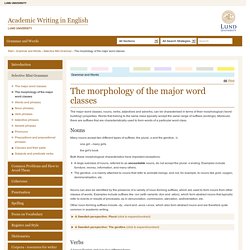

What part of speech is this? Here's how to figure it out. If you've ever found yourself wondering what part of speech a word is, you're not alone.

In this lesson, we'll explore how to answer that question as well as why that answer can seem a bit confusing. You'll also find a quiz at the bottom of the page so that you can test yourself. Pop quiz, hot shot! Let's say you're at the grocery store deciding between chunky and creamy peanut butter (tough choice) when someone walks up to you and asks, "What part of speech is the word love? " Obviously, the first thing to do is run away from this person. At that point, you would probably think of some example sentences to figure it out. I love peanut butter. From this sentence, you might conclude that love is a verb since you know that verbs express action, and love is showing an action in this sentence. Love for peanut butter brought me to the store today. Wait a minute! Parts of Speech .Thinglink.
Part of speech. History[edit] The classification of words into lexical categories is found from the earliest moments in the history of linguistics.[3] In the Nirukta, written in the 5th or 6th century BC, the Sanskrit grammarian Yāska defined four main categories of words:[4] nāma – nouns or substantivesākhyāta – verbsupasarga – pre-verbs or prefixesnipāta – particles, invariant words (perhaps prepositions) These four were grouped into two larger classes: inflected (nouns and verbs) and uninflected (pre-verbs and particles).

The ancient work on the grammar of the Tamil language, Tolkappiyam, dated variously between the 1st and 10th centuries AD, classifies Tamil words as peyar (noun), vinai (verb), idai (part of speech which modifies the relationships between verbs and nouns), and uri (word that further qualifies a noun or verb).[5] By the end of the 2nd century BC, this classification scheme had been expanded into eight categories, seen in the Art of Grammar:[7] There are nine parts of speech. ThePartsofSpeech A review for ESOL students There are nine parts of speech.

They are articles, nouns, pronouns, adjectives, verbs, adverbs, conjunctions, prepositions, and interjections. Parts of Speech- A playlist. Linking words. 36 FREE ESL Mr Bean worksheets. Parts of speech visual. Parts of Speech Table - learn English,parts_of_speech,grammar,english. AppCrawlr: Best iOS apps for Parts of Speech. Parts of Speech App.
Eponyms. Question Words in English - Who When What Why Which Where How. English Teachers: If you would like to use this Question Words wall chart in your classroom, then you can purchase a copy here: Question Words Wall Chart and Flash Cards. The most common question words in English are the following: WHO is only used when referring to people. (= I want to know the person) Who is the best football player in the world? Who are your best friends? Who is that strange guy over there?
WHERE is used when referring to a place or location. (= I want to know the place) Where is the library? WHEN is used to refer to a time or an occasion. (= I want to know the time) When do the shops open? WHY is used to obtain an explanation or a reason. (= I want to know the reason) Why do we need a nanny? Normally the response begins with "Because... " WHAT is used to refer to specific information. (= I want to know the thing) Sqworl Parts of speech. Old English Grammar. Academic Writing in English, Lund University. The major word classes, nouns, verbs, adjectives and adverbs, can be characterised in terms of their morphological ('word-building') properties.

Words that belong to the same class typically accept the same range of suffixes (endings). Moreover, there are suffixes that are characteristically used to form words of a particular word class. Nouns Many nouns accept two different types of suffixes: the plural -s and the genitive -'s. one girl - many girls the girl's book Both these morphological characteristics have important exceptions: A large subclass of nouns, referred to as uncountable nouns, do not accept the plural -s ending.
Nouns can also be identified by the presence of a variety of noun-forming suffixes, which are used to form nouns from other classes of words. Other noun-forming suffixes include -ity, -ment and -ance /-ence, which also form abstract nouns and are therefore quite common in academic writing.
Pronouns. Conjunctions. Interjections. Determiners ( Pre-central and post) Prepositions. Adverbs. Adjectives. Nouns.